Answered step by step
Verified Expert Solution
Question
1 Approved Answer
Can someone please help me with questions 1 - 6. Please see comments attached in blue and purple. Thank You so much for your help.
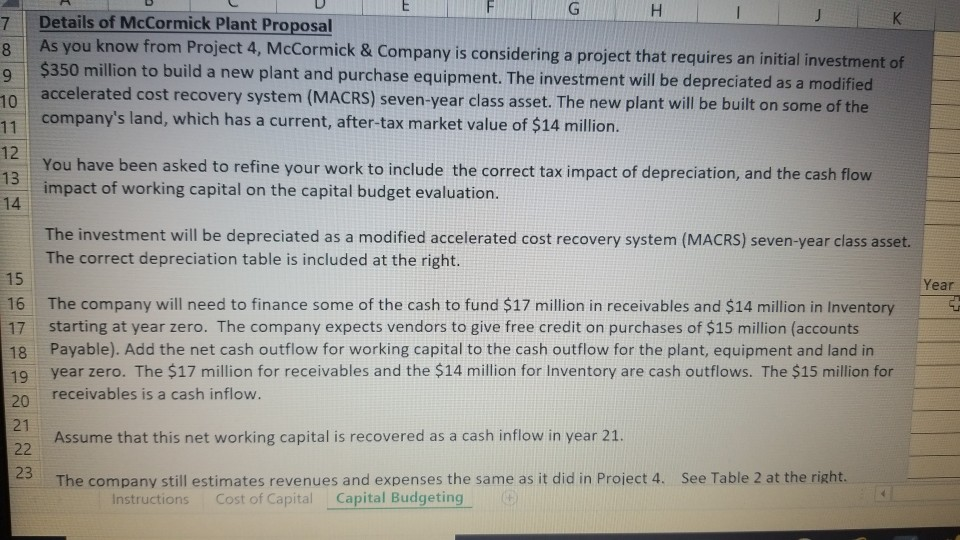
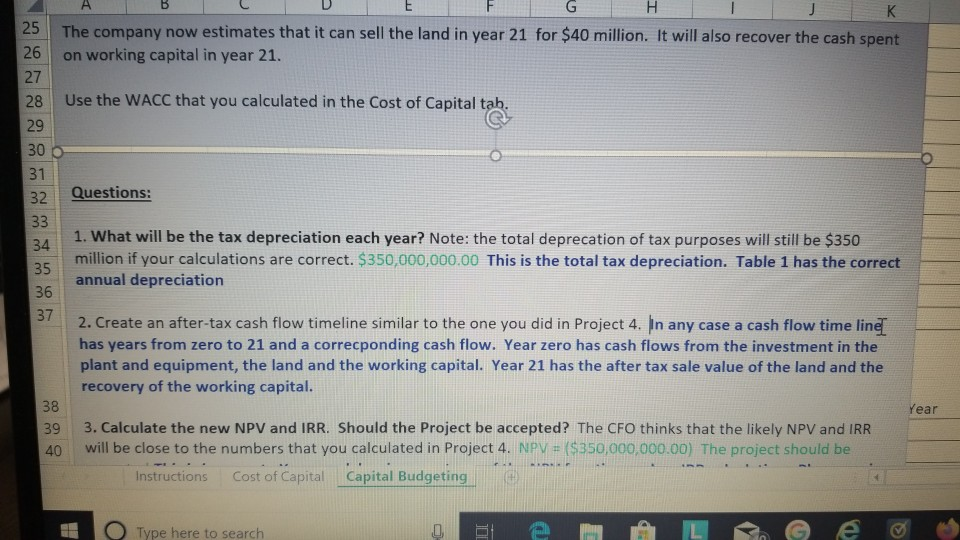
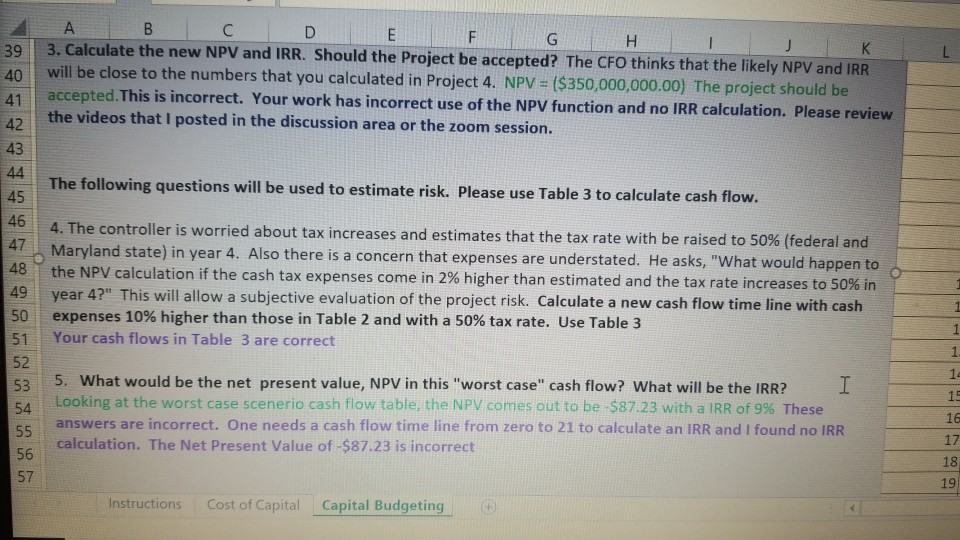
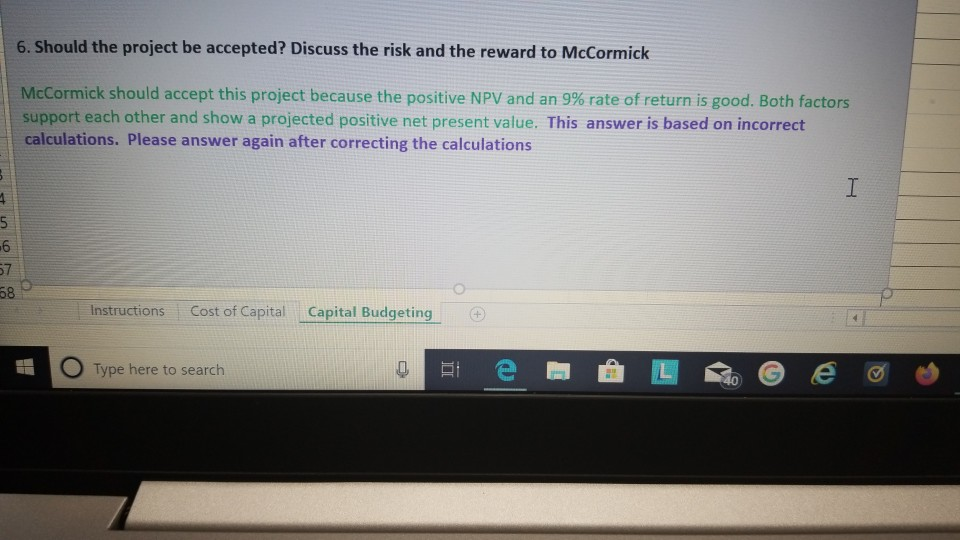
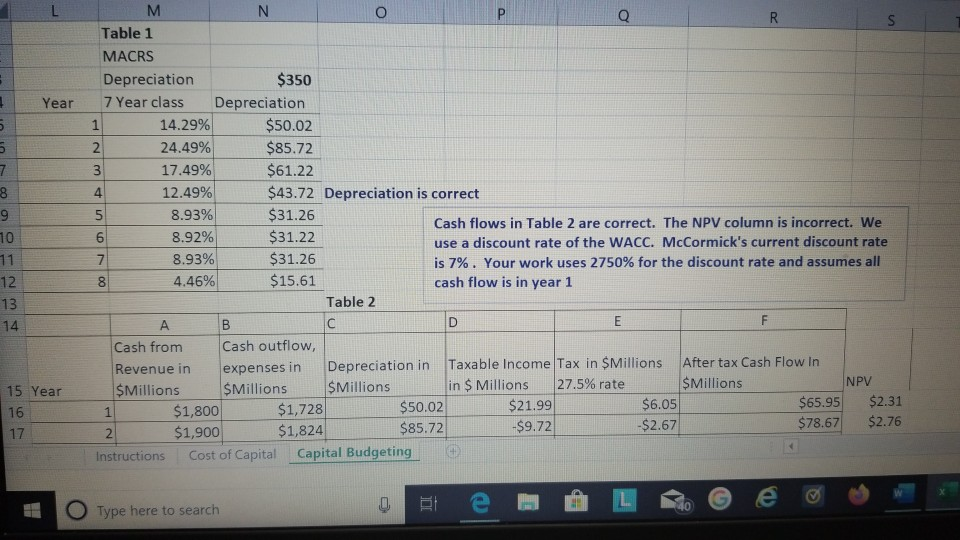
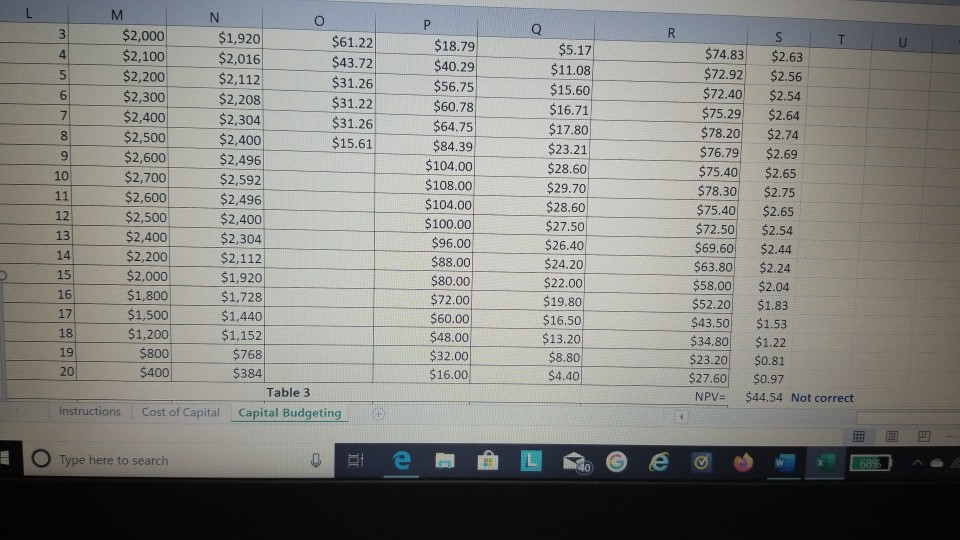
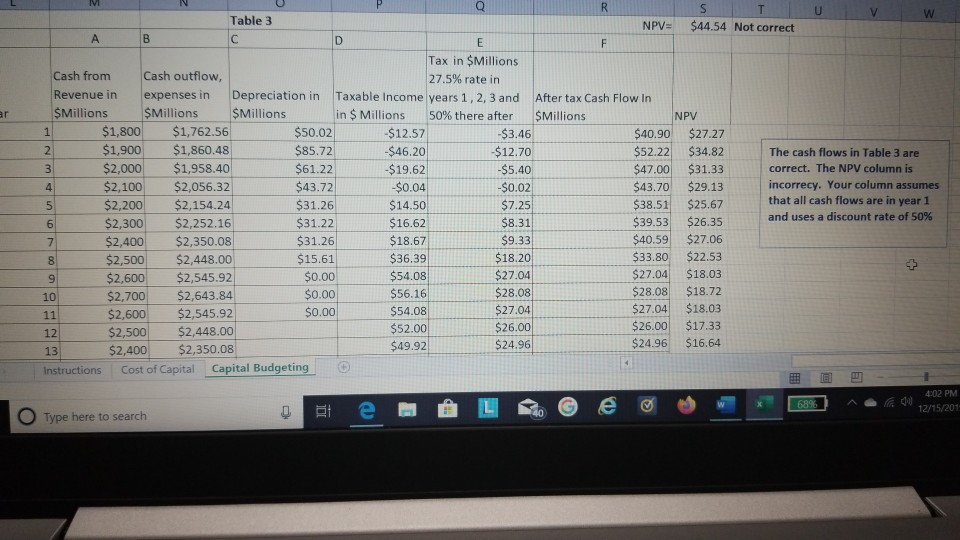
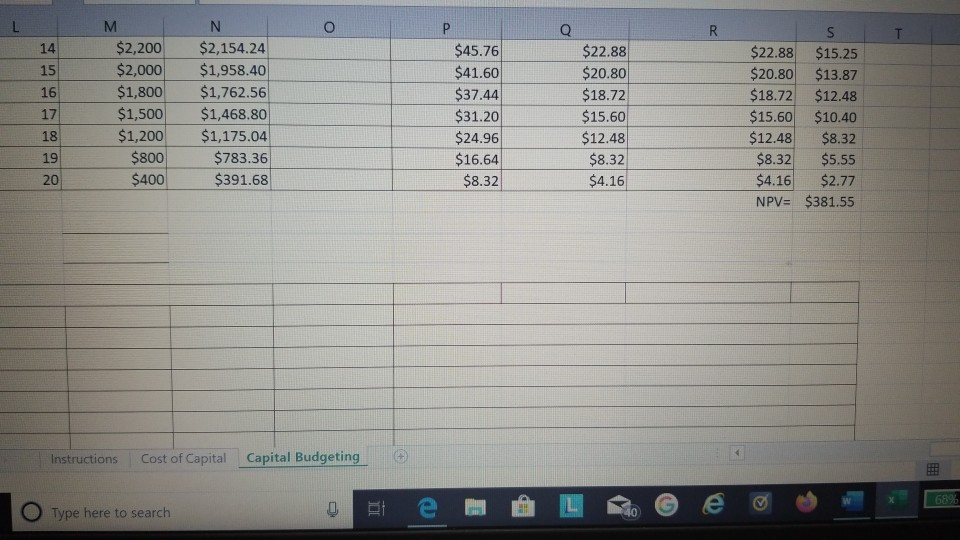
Can someone please help me with questions 1 - 6. Please see comments attached in blue and purple. Thank You so much for your help. I greatly appreciate it.
Details of McCormick Plant Proposal As you know from Project 4, McCormick & Company is considering a project that requires an initial investment of $350 million to build a new plant and purchase equipment. The investment will be depreciated as a modified K 9. accelerated cost recovery system (MACRS) seven-year class asset. The new plant will be built on some of the 10 company's land, which has a current, after-tax market value of $14 million. 11 12 You have been asked to refine your work to include the correct tax impact of depreciation, and the cash flow 13 impact of working capital on the capital budget evaluation. 14 The investment will be depreciated as a modified accelerated cost recovery system (MACRS) seven-year class asset. The correct depreciation table is included at the right. 15 Year The company will need to finance some of the cash to fund $17 million in receivables and $14 million in Inventory starting at year zero. The company expects vendors to give free credit on purchases of $15 million (accounts 16 17 Payable). Add the net cash outflow for working capital to the cash outflow for the plant, equipment and land in 18 year zero. The $17 million for receivables and the $14 million for Inventory are cash outflows. The $15 million for 19 receivables is a cash inflow. 20 21 Assume that this net working capital is recovered as a cash inflow in year 21. 22 23 The company still estimates revenues and expenses the same as it did in Project 4. See Table 2 at the right. Capital Budgeting Instructions Cost of Capital H. K 25 The company now estimates that it can sell the land in year 21 for $40 million. It will also recover the cash spent 26 on working capital in year 21. 27 Use the WACC that you calculated in the Cost of Capital tab. 28 29 30 o 31 Questions: 32 33 1. What will be the tax depreciation each year? Note: the total deprecation of tax purposes will still be $350 34 million if your calculations are correct. $350,000,000.00 This is the total tax depreciation. Table 1 has the correct 35 annual depreciation 36 37 2. Create an after-tax cash flow timeline similar to the one you did in Project 4. In any case a cash flow time line has years from zero to 21 and a correcponding cash flow. Year zero has cash flows from the investment in the plant and equipment, the land and the working capital. Year 21 has the after tax sale value of the land and the recovery of the working capital. 38 Year 3. Calculate the new NPV and IRR. Should the Project be accepted? The CFO thinks that the likely NPV and IRR will be close to the numbers that you calculated in Project 4. NPV = ($350,000,000.00) The project should be 39 40 Instructions Cost of Capital Capital Budgeting Type here to search B. G H. 3. Calculate the new NPV and IRR. Should the Project be accepted? The CFO thinks that the likely NPV and IRR K 39 will be close to the numbers that you calculated in Project 4. NPV = ($350,000,000.00) The project should be 40 41 accepted.This is incorrect. Your work has incorrect use of the NPV function and no IRR calculation. Please review the videos that I posted in the discussion area or the zoom session. 42 43 44 The following questions will be used to estimate risk. Please use Table 3 to calculate cash flow. 45 46 4. The controller is worried about tax increases and estimates that the tax rate with be raised to 50% (federal and 47 Maryland state) in year 4. Also there is a concern that expenses are understated. He asks, "What would happen to 48 the NPV calculation if the cash tax expenses come in 2% higher than estimated and the tax rate increases to 50% in year 4?" This will allow a subjective evaluation of the project risk. Calculate a new cash flow time line with cash expenses 10% higher than those in Table 2 and with a 50% tax rate. Use Table 3 Your cash flows in Table 3 are correct 49 50 51 1. 52 14 5. What would be the net present value, NPV in this "worst case" cash flow? What will be the IRR? 53 15 Looking at the worst case scenerio cash flow table, the NPV comes out to be -$87.23 with a IRR of 9% These 54 16 answers are incorrect. One needs a cash flow time line from zero to 21 to calculate an IRR and I found no IRR 55 17 calculation. The Net Present Value of -$87.23 is incorrect 56 18 57 19 Cost of Capital Instructions Capital Budgeting 6. Should the project be accepted? Discuss the risk and the reward to McCormick McCormick should accept this project because the positive NPV and an 9% rate of return is good. Both factors support each other and showa projected positive net present value. This answer is based on incorrect calculations. Please answer again after correcting the calculations I. -6 57 58 Cost of Capital Instructions Capital Budgeting Type here to search 40 Table 1 MACRS $350 Depreciation 7 Year class Depreciation Year 14.29% 24.49% 17.49% $50.02 $85.72 $61.22 12.49% $43.72 Depreciation is correct 4 8.93% $31.26 Cash flows in Table 2 are correct. The NPV column is incorrect. We use a discount rate of the WACC. McCormick's current discount rate is 7%. Your work uses 2750% for the discount rate and assumes all 10 11 $31.22 8.92% 8.93% $31.26 $15.61 4.46% 12 cash flow is in year 1 Table 2 13 D IC 14 A. Cash outflow, Cash from Depreciation in Taxable Income Tax in $Millions $Millions $1,728 After tax Cash Flow In expenses in $Millions Revenue in $Millions $6.05 -$2.67 27.5% rate NPV in $ Millions $Millions 15 Year $65.95 $78.67 $2.31 $21.99 $50.02 $85.72 $1,800 16 $2.76 -$9.72 $1,900 $1,824 17 2. Capital Budgeting Cost of Capital Instructions O Type here to search P. 00 2. N. $2,000 $2,100 $2,200 $2,300 $2,400 $2,500 $2,600 $2,700 $2,600 $2,500 $2,400 $2,200 $2,000 $1,800 R. $1,920 $2,016 $2,112 $2,208 $2,304 $2,400 $2,496 $2,592 $2,496 $2,400 $2,304 $61.22 $43.72 $31.26 $31.22 $31.26 $15.61 T. $18.79 $40.29 $5.17 $11.08 $15.60 $16.71 $17.80 $23.21 $28.60 $29.70 $28.60 $27.50 $26.40 $74.83 $72.92 $72.40 $75.29 $78.20 $76.79 $75.40 $78.30 $75.40 $72.50 $69.60 $63.80 $58.00 $52.20 $43.50 $34.80 $23.20 $2.63 $2.56 $56.75 $2.54 $60.78 $64.75 $84.39 $104.00 $108.00 $104.00 $100.00 $2.64 7. $2.74 8. $2.69 9. $2.65 10 $2.75 11 $2.65 12 $2.54 13 $96.00 $88.00 $80.00 $72.00 $60.00 $48.00 $32.00 $16.00 $2.44 14 $2,112 $24.20 $22.00 $19.80 $16.50 $13.20 $2.24 $1,920 $1,728 $1,440 $1,152 $768 $384 15 $2.04 16 $1.83 $1,500 $1,200 17 $1.53 $1.22 $0.81 18 $800 19 $8.80 $400 20 $4.40 $27.60 $0.97 $44.54 Not correct Table 3 NPV= Instructions Capital Budgeting Cost of Capital O Type here to search 68% R. Table 3 $44.54 Not correct NPV= Tax in $Millions Cash outflow, Cash from 27.5% rate in Depreciation in Revenue in Taxable Income years 1, 2, 3 and expenses in $Millions After tax Cash Flow In $Millions $Millions in $ Millions NPV $40.90 ar $Millions 50% there after $1,800 $1,762.56 -$12.57 -$46.20 $50.02 -$3.46 $27.27 $1,900 $1,860.48 $85.72 The cash flows in Table 3 are 2. $12.70 -$5.40 $52.22 $34.82 $1,958.40 $2,000 $2,100 $2,200 $2,300 $61.22 $43.72 $31.26 $31.22 $31.26 -$19.62 $47.00 $31.33 correct. The NPV column is incorrecy. Your column assumes that all cash flows are in year 1 -$0.02 $2,056.32 $43.70 $29.13 -$0.04 $2,154.24 $14.50 $38.51 $25.67 $7.25 and uses a discount rate of 50% $16.62 $18.67 $36.39 $8.31 $39.53 $26.35 $2,252.16 6. $40.59 $27.06 $9.33 $2,400 $2,500 $2,600 $2,350.08 7. $33.80 $22.53 $18.20 $27.04 $28.08 $2,448.00 $2,545.92 $2,643.84 $2,545.92 $2,448.00 $15.61 $27.04 $18.03 $0.00 $54.08 $28.08 $18.72 $56.16 $0.00 $2,700 $18.03 $27.04 $0.00 $27.04 $54.08 $2,600 11 $17.33 $52.00 $49.92 $26.00 $26.00 $2,500 12 $24.96 $16.64 $24.96 $2,350.08 $2,400 13 Capital Budgeting Cost of Capital Instructions 4:02 PM 68% 12/15/201 Type here to search Wn B. T. $2,200 $2,000 $2,154.24 $1,958.40 $1,762.56 $1,468.80 $1,175.04 $45.76 $41.60 $37.44 $22.88 $20.80 14 $22.88 $20.80 $15.25 15 $13.87 $12.48 $10.40 $8.32 $1,800 $1,500 $1,200 $800 $400 16 $18.72 $15.60 $12.48 $18.72 $15.60 17 $31.20 18 $24.96 $12.48 $16.64 $8.32 $783.36 19 $8.32 $5.55 $391.68 $4.16 $8.32 $4.16 $2.77 NPV= $381.55 20 Cost of Capital Capital Budgeting Instructions 68% O Type here to search Details of McCormick Plant Proposal As you know from Project 4, McCormick & Company is considering a project that requires an initial investment of $350 million to build a new plant and purchase equipment. The investment will be depreciated as a modified K 9. accelerated cost recovery system (MACRS) seven-year class asset. The new plant will be built on some of the 10 company's land, which has a current, after-tax market value of $14 million. 11 12 You have been asked to refine your work to include the correct tax impact of depreciation, and the cash flow 13 impact of working capital on the capital budget evaluation. 14 The investment will be depreciated as a modified accelerated cost recovery system (MACRS) seven-year class asset. The correct depreciation table is included at the right. 15 Year The company will need to finance some of the cash to fund $17 million in receivables and $14 million in Inventory starting at year zero. The company expects vendors to give free credit on purchases of $15 million (accounts 16 17 Payable). Add the net cash outflow for working capital to the cash outflow for the plant, equipment and land in 18 year zero. The $17 million for receivables and the $14 million for Inventory are cash outflows. The $15 million for 19 receivables is a cash inflow. 20 21 Assume that this net working capital is recovered as a cash inflow in year 21. 22 23 The company still estimates revenues and expenses the same as it did in Project 4. See Table 2 at the right. Capital Budgeting Instructions Cost of Capital H. K 25 The company now estimates that it can sell the land in year 21 for $40 million. It will also recover the cash spent 26 on working capital in year 21. 27 Use the WACC that you calculated in the Cost of Capital tab. 28 29 30 o 31 Questions: 32 33 1. What will be the tax depreciation each year? Note: the total deprecation of tax purposes will still be $350 34 million if your calculations are correct. $350,000,000.00 This is the total tax depreciation. Table 1 has the correct 35 annual depreciation 36 37 2. Create an after-tax cash flow timeline similar to the one you did in Project 4. In any case a cash flow time line has years from zero to 21 and a correcponding cash flow. Year zero has cash flows from the investment in the plant and equipment, the land and the working capital. Year 21 has the after tax sale value of the land and the recovery of the working capital. 38 Year 3. Calculate the new NPV and IRR. Should the Project be accepted? The CFO thinks that the likely NPV and IRR will be close to the numbers that you calculated in Project 4. NPV = ($350,000,000.00) The project should be 39 40 Instructions Cost of Capital Capital Budgeting Type here to search B. G H. 3. Calculate the new NPV and IRR. Should the Project be accepted? The CFO thinks that the likely NPV and IRR K 39 will be close to the numbers that you calculated in Project 4. NPV = ($350,000,000.00) The project should be 40 41 accepted.This is incorrect. Your work has incorrect use of the NPV function and no IRR calculation. Please review the videos that I posted in the discussion area or the zoom session. 42 43 44 The following questions will be used to estimate risk. Please use Table 3 to calculate cash flow. 45 46 4. The controller is worried about tax increases and estimates that the tax rate with be raised to 50% (federal and 47 Maryland state) in year 4. Also there is a concern that expenses are understated. He asks, "What would happen to 48 the NPV calculation if the cash tax expenses come in 2% higher than estimated and the tax rate increases to 50% in year 4?" This will allow a subjective evaluation of the project risk. Calculate a new cash flow time line with cash expenses 10% higher than those in Table 2 and with a 50% tax rate. Use Table 3 Your cash flows in Table 3 are correct 49 50 51 1. 52 14 5. What would be the net present value, NPV in this "worst case" cash flow? What will be the IRR? 53 15 Looking at the worst case scenerio cash flow table, the NPV comes out to be -$87.23 with a IRR of 9% These 54 16 answers are incorrect. One needs a cash flow time line from zero to 21 to calculate an IRR and I found no IRR 55 17 calculation. The Net Present Value of -$87.23 is incorrect 56 18 57 19 Cost of Capital Instructions Capital Budgeting 6. Should the project be accepted? Discuss the risk and the reward to McCormick McCormick should accept this project because the positive NPV and an 9% rate of return is good. Both factors support each other and showa projected positive net present value. This answer is based on incorrect calculations. Please answer again after correcting the calculations I. -6 57 58 Cost of Capital Instructions Capital Budgeting Type here to search 40 Table 1 MACRS $350 Depreciation 7 Year class Depreciation Year 14.29% 24.49% 17.49% $50.02 $85.72 $61.22 12.49% $43.72 Depreciation is correct 4 8.93% $31.26 Cash flows in Table 2 are correct. The NPV column is incorrect. We use a discount rate of the WACC. McCormick's current discount rate is 7%. Your work uses 2750% for the discount rate and assumes all 10 11 $31.22 8.92% 8.93% $31.26 $15.61 4.46% 12 cash flow is in year 1 Table 2 13 D IC 14 A. Cash outflow, Cash from Depreciation in Taxable Income Tax in $Millions $Millions $1,728 After tax Cash Flow In expenses in $Millions Revenue in $Millions $6.05 -$2.67 27.5% rate NPV in $ Millions $Millions 15 Year $65.95 $78.67 $2.31 $21.99 $50.02 $85.72 $1,800 16 $2.76 -$9.72 $1,900 $1,824 17 2. Capital Budgeting Cost of Capital Instructions O Type here to search P. 00 2. N. $2,000 $2,100 $2,200 $2,300 $2,400 $2,500 $2,600 $2,700 $2,600 $2,500 $2,400 $2,200 $2,000 $1,800 R. $1,920 $2,016 $2,112 $2,208 $2,304 $2,400 $2,496 $2,592 $2,496 $2,400 $2,304 $61.22 $43.72 $31.26 $31.22 $31.26 $15.61 T. $18.79 $40.29 $5.17 $11.08 $15.60 $16.71 $17.80 $23.21 $28.60 $29.70 $28.60 $27.50 $26.40 $74.83 $72.92 $72.40 $75.29 $78.20 $76.79 $75.40 $78.30 $75.40 $72.50 $69.60 $63.80 $58.00 $52.20 $43.50 $34.80 $23.20 $2.63 $2.56 $56.75 $2.54 $60.78 $64.75 $84.39 $104.00 $108.00 $104.00 $100.00 $2.64 7. $2.74 8. $2.69 9. $2.65 10 $2.75 11 $2.65 12 $2.54 13 $96.00 $88.00 $80.00 $72.00 $60.00 $48.00 $32.00 $16.00 $2.44 14 $2,112 $24.20 $22.00 $19.80 $16.50 $13.20 $2.24 $1,920 $1,728 $1,440 $1,152 $768 $384 15 $2.04 16 $1.83 $1,500 $1,200 17 $1.53 $1.22 $0.81 18 $800 19 $8.80 $400 20 $4.40 $27.60 $0.97 $44.54 Not correct Table 3 NPV= Instructions Capital Budgeting Cost of Capital O Type here to search 68% R. Table 3 $44.54 Not correct NPV= Tax in $Millions Cash outflow, Cash from 27.5% rate in Depreciation in Revenue in Taxable Income years 1, 2, 3 and expenses in $Millions After tax Cash Flow In $Millions $Millions in $ Millions NPV $40.90 ar $Millions 50% there after $1,800 $1,762.56 -$12.57 -$46.20 $50.02 -$3.46 $27.27 $1,900 $1,860.48 $85.72 The cash flows in Table 3 are 2. $12.70 -$5.40 $52.22 $34.82 $1,958.40 $2,000 $2,100 $2,200 $2,300 $61.22 $43.72 $31.26 $31.22 $31.26 -$19.62 $47.00 $31.33 correct. The NPV column is incorrecy. Your column assumes that all cash flows are in year 1 -$0.02 $2,056.32 $43.70 $29.13 -$0.04 $2,154.24 $14.50 $38.51 $25.67 $7.25 and uses a discount rate of 50% $16.62 $18.67 $36.39 $8.31 $39.53 $26.35 $2,252.16 6. $40.59 $27.06 $9.33 $2,400 $2,500 $2,600 $2,350.08 7. $33.80 $22.53 $18.20 $27.04 $28.08 $2,448.00 $2,545.92 $2,643.84 $2,545.92 $2,448.00 $15.61 $27.04 $18.03 $0.00 $54.08 $28.08 $18.72 $56.16 $0.00 $2,700 $18.03 $27.04 $0.00 $27.04 $54.08 $2,600 11 $17.33 $52.00 $49.92 $26.00 $26.00 $2,500 12 $24.96 $16.64 $24.96 $2,350.08 $2,400 13 Capital Budgeting Cost of Capital Instructions 4:02 PM 68% 12/15/201 Type here to search Wn B. T. $2,200 $2,000 $2,154.24 $1,958.40 $1,762.56 $1,468.80 $1,175.04 $45.76 $41.60 $37.44 $22.88 $20.80 14 $22.88 $20.80 $15.25 15 $13.87 $12.48 $10.40 $8.32 $1,800 $1,500 $1,200 $800 $400 16 $18.72 $15.60 $12.48 $18.72 $15.60 17 $31.20 18 $24.96 $12.48 $16.64 $8.32 $783.36 19 $8.32 $5.55 $391.68 $4.16 $8.32 $4.16 $2.77 NPV= $381.55 20 Cost of Capital Capital Budgeting Instructions 68% O Type here to searchStep by Step Solution
There are 3 Steps involved in it
Step: 1

Get Instant Access to Expert-Tailored Solutions
See step-by-step solutions with expert insights and AI powered tools for academic success
Step: 2

Step: 3

Ace Your Homework with AI
Get the answers you need in no time with our AI-driven, step-by-step assistance
Get Started


